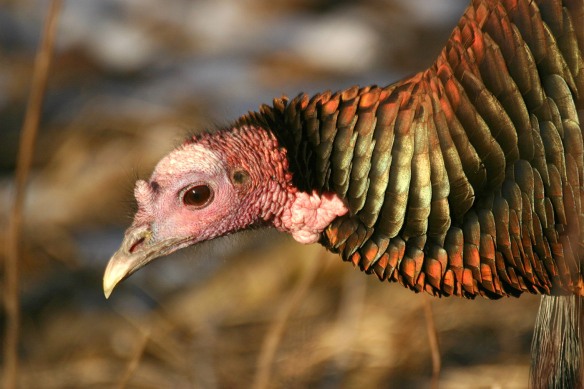Here is the latest For the Birds column, which runs in several New England newspapers.
…
Somehow, it’s time for Thanksgiving already. It feels like yesterday that we were welcoming 2017 — by the way, how did those resolutions turn out?
And here we are at turkey time.
Speaking of turkey time, as I often do at this time of year, I will focus this column on the wild turkey.
After a few failed attempts, reintroduction programs in the 1970s and 1990s successfully brought the bird back to New England. The wild turkey again thrives in our region.
I have seen turkeys a few hundred feet from Long Island Sound at a park in southern Connecticut, and I have seen them on camping trips to Pittsburg, N.H., near the Canadian border. They are abundant everywhere in between, too.
I often hear from readers who share stories about wild turkeys, so clearly they are welcomed back as a familiar part of our landscape.
Here are some more facts about one of New England’s largest birds, with appreciation — it is Thanksgiving, after all— to the Wild Turkey Federation:
Wild Turkeys eat acorns and other mast (hard fruit), fleshy fruits, corn, a variety of seeds, and invertebrates. Young turkeys (poults) feed heavily on insects, including ticks.
Few predators are able to catch an adult wild turkey. The turkey’s well-developed instinct for survival and excellent eyesight and hearing help to keep it out of harm’s way.
Their survival instincts and keen eyesight also make wild turkeys difficult to hunt, even though they are one of the most popular game species in the region. Turkeys also have excellent hearing, so sneaking up on a turkey on the leaf-covered floor of the woods is not a good hunting strategy.
Five subspecies of wild turkey inhabit 49 states (not Alaska). The subspecies in New England ranges from southern Maine to northern Florida, west to eastern Texas and north to North Dakota.
Wild turkey meat is packed with protein and is low in cholesterol and harmful fats. Store-bought turkeys are also healthy, but may also contain steroids, antibiotics or other man-made chemicals.
Although many photographs show male turkeys in a strut position, the birds are rarely in that posture. Strutting is used in the mating season to show off in front of hens (female turkeys) and to show dominance over other males. It is also used sparingly in other seasons. The strut shows off the 18 tail feathers of a turkey.
Quick facts: There are an estimated 6.5 million wild turkeys in the U.S; the average life span is 2.5 years; they weigh up to 17 pounds; they can run up to 25 miles per hour.
A male turkey is a tom; a young male is a jake. A female turkey is a hen; a young female is a jenny. A baby turkey is a poult. A group of turkeys is a flock.
Enjoy your Thanksgiving. Safe travels. Go Vikings. Oh, and let me know if you see any wild turkeys out there.


Chris, Continue to enjoy your columns. Hope you have a wonderful Turkey day with your boys. Think you’ll like the attached – taken here in Florida a year or two ago. jim >
LikeLike
Saw a flock of about 21 birds crossing the rail trail in Ayer, Massachusetts back on Nov. 3. Largest flock I’ve seen around.
LikeLike